You'll find several excellent plant options to insulate your roof and cut energy costs. Sedum, a versatile succulent, creates a living blanket that regulates temperature year-round. Wildflowers offer both cooling effects and visual appeal. Grasses provide lightweight insulation ideal for roofs with limited load capacity. Drought-resistant succulents thrive in harsh conditions while cooling your home. Herbs act as fragrant thermal barriers, and mosses form dense, temperature-regulating mats. You can even grow vegetables for edible insulation. Native plants adapt well to local climates, while strategically placed trees offer shade and energy efficiency. Exploring these options will reveal the perfect green solution for your home.
Sedum: Nature's Rooftop Insulator
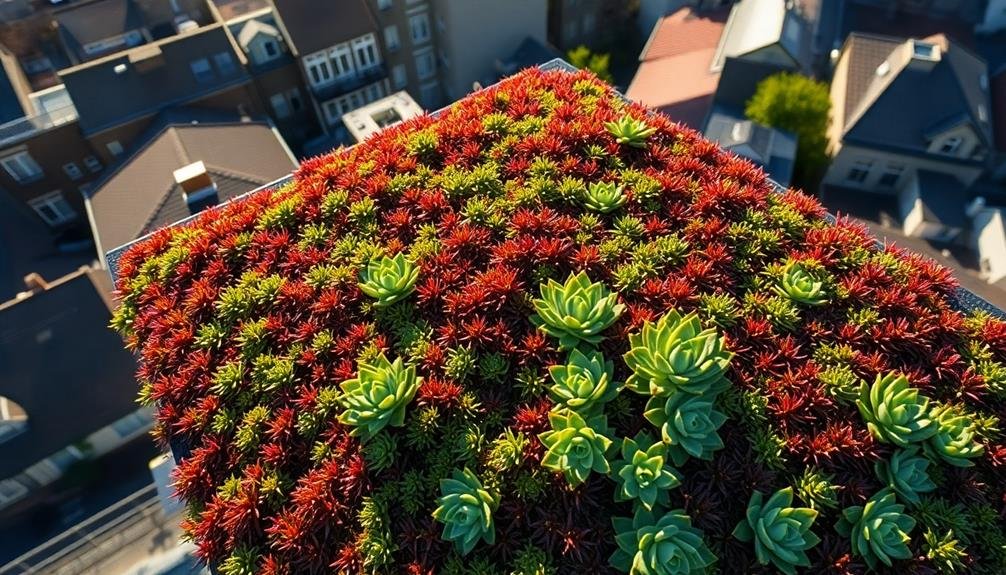
On top of your roof, sedum plants offer an excellent natural insulation solution.
These hardy succulents create a living blanket that regulates your home's temperature year-round. Sedum's thick, fleshy leaves and stems store water, making them drought-resistant and low-maintenance. They form a dense mat that absorbs heat in summer and retains warmth in winter, reducing your energy costs.
You'll find sedum in various colors and textures, from vibrant greens to reds and yellows.
This diversity allows you to create an aesthetically pleasing rooftop garden while benefiting from its insulating properties. Sedum's shallow root system won't damage your roof structure, and its ability to withstand extreme temperatures makes it ideal for diverse climates.
Installing a sedum roof is straightforward.
You'll need a waterproof membrane, drainage layer, growing medium, and sedum plants or pre-grown mats. Once established, your sedum roof will require minimal care, occasional weeding, and light fertilization.
It'll also absorb rainwater, reducing runoff and helping manage stormwater. By choosing sedum for your roof, you're not only insulating your home but also contributing to urban biodiversity and creating a more sustainable living environment.
Wildflowers for Cooling and Beauty
You'll find wildflowers to be an excellent choice for roof insulation, offering both cooling effects and aesthetic appeal.
To get started, you'll want to contemplate varieties like Black-Eyed Susans, Coneflowers, and Blanket Flowers, which are resilient and well-suited for rooftop environments.
Proper planting techniques and regular maintenance, including watering and pruning, will guarantee your wildflower roof garden thrives while providing effective insulation for your home.
Best Wildflower Varieties
While wildflowers aren't typically associated with roof gardens, they can be excellent choices for home insulation and aesthetic appeal. You'll want to select varieties that are drought-tolerant, low-growing, and well-suited to your climate. Consider native species, as they're often more resilient and require less maintenance.
For sunny rooftops, try planting Black-Eyed Susans, which offer vibrant yellow blooms and excellent heat resistance. Sedum, also known as stonecrop, is another great option with its succulent leaves and diverse color range. California Poppies are perfect for their drought tolerance and striking orange flowers.
In partially shaded areas, you can't go wrong with Columbine, known for its delicate, bell-shaped blooms. Coreopsis is another versatile choice, offering daisy-like flowers in various hues. For a pop of purple, consider adding some hardy Violets or Pansies.
Don't forget about grasses like Blue Fescue or Little Bluestem, which provide excellent insulation and a unique texture.
Planting and Maintenance Tips
Planting and maintaining wildflowers on your roof requires five key steps for success. First, confirm your roof can support the additional weight of soil and plants. Install a waterproof membrane and root barrier to protect your roof structure.
Next, choose a lightweight growing medium designed for green roofs, typically a mix of compost, perlite, and sand. When sowing seeds, scatter them evenly across the prepared soil and lightly press them in. Water gently but thoroughly, keeping the soil moist until germination occurs.
Once established, most wildflowers are drought-tolerant, but you'll need to water during prolonged dry spells. Regularly inspect your roof garden for weeds and remove them promptly. Trim dead flowers to encourage continuous blooming and prevent self-seeding.
In fall, cut back spent plants to about 6 inches tall. You'll need to replenish the soil annually with a thin layer of compost to maintain nutrient levels. Every few years, you may need to reseed sparse areas to keep your wildflower roof lush and vibrant.
Grasses: Lightweight Insulation Champions
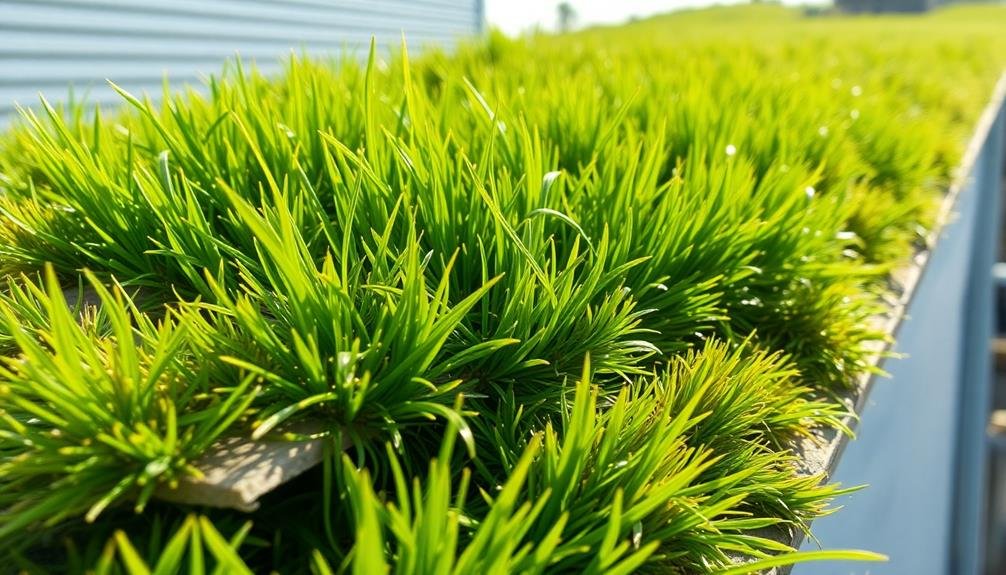
Among the various roof plant options, grasses stand out as lightweight insulation champions. They're ideal for roofs with limited load-bearing capacity, offering excellent insulation without compromising structural integrity. You'll find that grass varieties like fescues, sedges, and meadow grasses are particularly effective.
These grasses create a dense mat of foliage and roots that traps air, forming a natural insulation layer. This helps regulate your home's temperature, keeping it cooler in summer and warmer in winter. You'll notice reduced energy costs as your HVAC system works less to maintain comfortable indoor temperatures.
When selecting grasses for your roof, consider drought-tolerant species that can withstand periods of low rainfall. Native grasses are often the best choice, as they're adapted to your local climate and require less maintenance.
You'll need to guarantee proper drainage and a root barrier to protect your roof's structure. Regular mowing and occasional fertilization will keep your grass roof healthy and effective.
With proper care, your grass roof can provide excellent insulation for years, while also offering a unique, eco-friendly aesthetic to your home.
Succulents: Drought-Resistant Roof Coolers
Succulents offer another excellent option for roof insulation, particularly in arid climates. These water-storing plants thrive in hot, dry conditions and require minimal maintenance, making them ideal for green roofs in regions with limited rainfall. You'll find that succulents like sedum, echeveria, and sempervivum are popular choices due to their hardiness and shallow root systems.
When you install succulents on your roof, you're creating a natural cooling system. Their thick, fleshy leaves absorb and store water, which evaporates slowly, helping to regulate roof temperature. This process can greatly reduce your home's cooling costs during hot summers. Additionally, succulents' ability to reflect sunlight further enhances their insulating properties.
You'll appreciate that succulents form a dense, low-growing mat that protects your roof from UV radiation and extreme temperature fluctuations. This protective layer can extend the lifespan of your roofing materials.
As an added bonus, many succulent species produce colorful flowers, transforming your roof into an attractive, eco-friendly feature. With their drought resistance and insulating capabilities, succulents prove to be an excellent choice for sustainable roof plantings in warm, dry climates.
Herbs: Fragrant Thermal Barriers
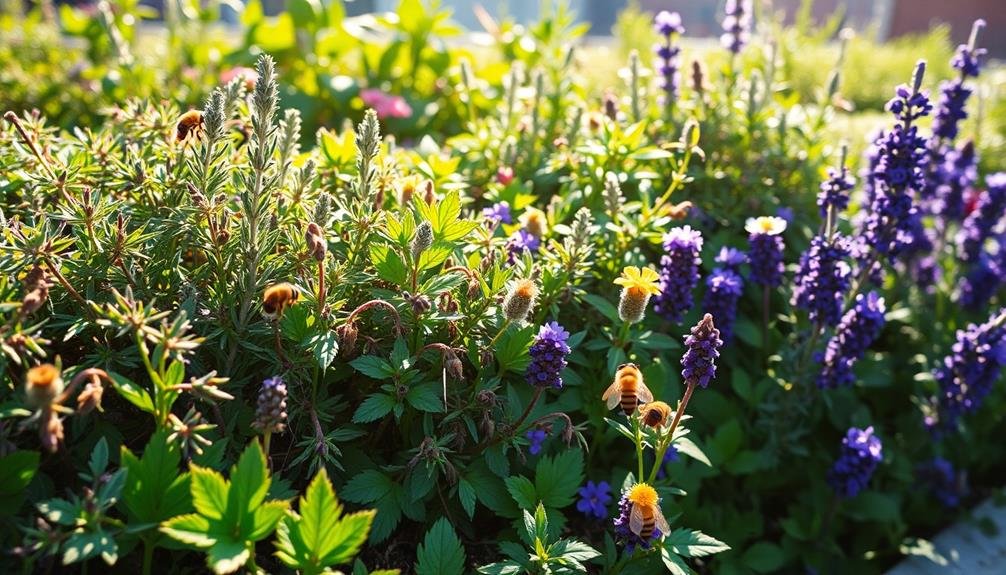
Herbs provide a dual benefit when used for roof insulation, offering both thermal protection and aromatic appeal. You'll find that many hardy herbs can thrive in rooftop conditions, creating a living blanket that helps regulate your home's temperature. Varieties like thyme, oregano, and sage are particularly well-suited for this purpose, as they're drought-resistant and can withstand direct sunlight.
These fragrant plants create an air pocket between your roof and the environment, reducing heat transfer. Their leaves reflect sunlight, while their roots help absorb rainwater, further cooling your home. You'll also enjoy the added bonus of fresh herbs for cooking, right from your roof.
When planting herbs for insulation, confirm you've got a proper green roof system in place. This includes a waterproof membrane, root barrier, and adequate drainage.
Choose a mix of herbs with varying heights and textures to maximize insulation effectiveness. Don't forget to take into account your local climate and roof load capacity when selecting plants.
With proper care, your herb roof garden will provide year-round insulation and a delightful sensory experience.
Mosses: Low-Maintenance Temperature Regulators
Mosses offer an excellent low-maintenance option for roof insulation. These small, non-vascular plants create a dense mat that effectively regulates temperature by absorbing heat in summer and providing insulation in winter.
You'll find mosses easy to establish and care for, as they require minimal soil and can thrive in shaded areas.
When selecting mosses for your roof, consider species like Hypnum cupressiforme or Bryum argenteum, which are known for their resilience and insulating properties. These varieties can withstand varying weather conditions and help reduce your energy costs year-round.
To install moss on your roof, guarantee proper waterproofing and drainage. Start by applying a thin layer of growing medium, then introduce moss fragments or spores. Water regularly until the moss establishes itself, which typically takes a few months.
One of the most significant advantages of using mosses is their ability to absorb rainwater, reducing runoff and helping to prevent water damage. They also act as natural air purifiers, trapping pollutants and improving air quality around your home.
Remember to inspect your moss-covered roof periodically for any signs of excessive growth or damage to the underlying structure.
Vegetable Gardens: Edible Insulation
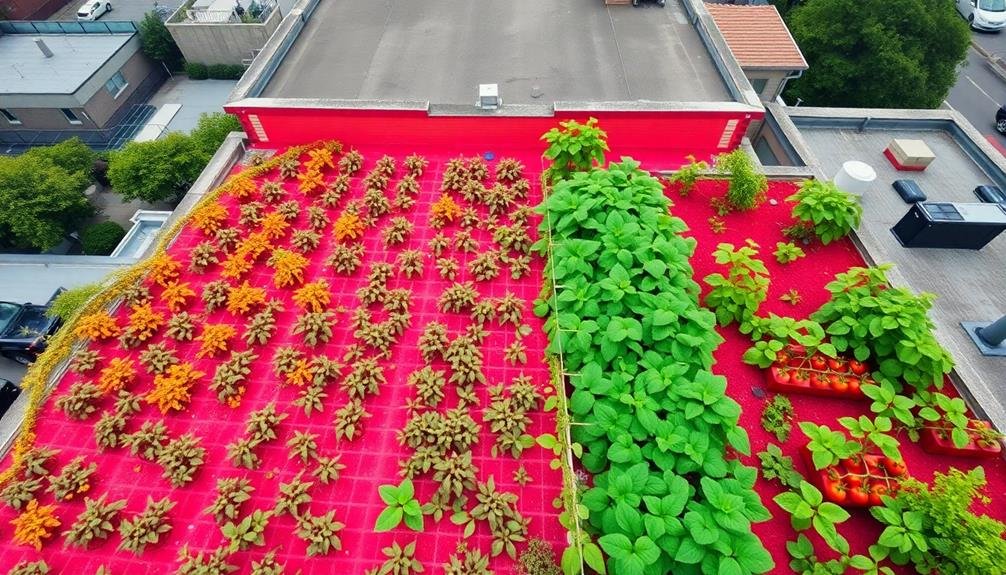
Along with providing insulation, rooftop vegetable gardens offer a delicious way to maximize your home's energy efficiency. You'll benefit from reduced heating and cooling costs while enjoying fresh, homegrown produce.
Leafy greens like lettuce, spinach, and kale are excellent choices for roof gardens, as their broad leaves create a dense canopy that absorbs sunlight and retains moisture.
Root vegetables such as carrots and radishes can help stabilize your rooftop soil, preventing erosion and enhancing insulation. Tomatoes and peppers, with their sprawling vines, provide additional coverage and shade. For year-round insulation, consider planting perennial herbs like thyme and oregano.
Before starting your edible roof garden, verify your roof can support the added weight of soil, plants, and water. Install a proper drainage system and use lightweight, nutrient-rich growing mediums.
You'll need to water your plants regularly, but this irrigation also contributes to the cooling effect. Remember to harvest your crops frequently to maintain healthy growth and prevent overloading your roof structure.
With proper planning and care, your vegetable garden can serve as both an effective insulator and a sustainable food source.
Native Plants for Regional Efficiency
Adaptability is key when choosing native plants for roof insulation. You'll want to select species that thrive in your local climate and can withstand the unique conditions of a rooftop environment. Native plants have evolved to survive in your region's specific conditions, making them ideal for efficient, low-maintenance insulation.
When selecting native plants for your roof, consider these factors:
- Drought tolerance: Rooftop environments often experience more extreme temperatures and less water retention.
- Root structure: Choose plants with shallow, fibrous roots to prevent damage to your roof.
- Growth habits: Opt for low-growing, spreading plants that provide maximum coverage.
- Seasonal changes: Select a mix of plants that offer year-round insulation benefits.
You'll find that native plants require less water, fertilizer, and overall maintenance than non-native species. They're also more resistant to local pests and diseases, reducing the need for chemical treatments.
By choosing native plants, you're not only improving your home's insulation but also supporting local ecosystems and biodiversity.
Research your region's native plant species and consult with local nurseries or botanical gardens for expert advice on the best options for your roof insulation project.
Trees: Shade-Providing Insulation Powerhouses
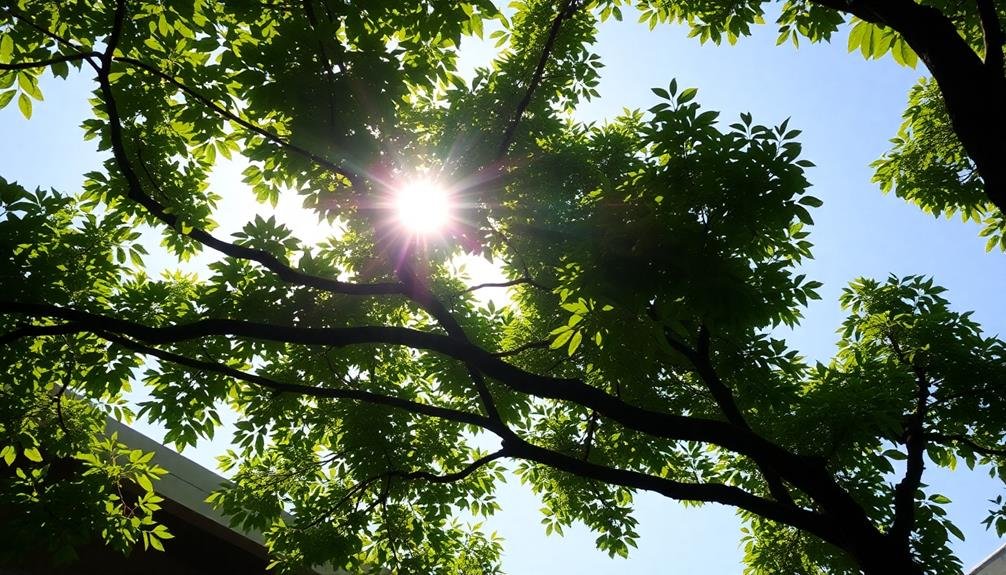
When considering trees for home insulation, you'll need to weigh the benefits of deciduous versus evergreen varieties.
Deciduous trees offer excellent summer shade while allowing winter sunlight, whereas evergreens provide year-round protection.
To maximize energy efficiency, you should strategically place trees on the south and west sides of your home, considering factors like mature tree size and proximity to the building.
Deciduous vs. Evergreen Trees
Trees are the shade-providing powerhouses of roof insulation, and choosing between deciduous and evergreen varieties can greatly impact your home's energy efficiency.
Deciduous trees offer seasonal benefits, shedding leaves in winter to allow sunlight through while providing shade in summer. Evergreens, on the other hand, maintain their foliage year-round, offering consistent insulation.
When selecting trees for your roof insulation strategy, consider:
- Climate: Deciduous trees work well in areas with distinct seasons, while evergreens are ideal for consistently warm or cold climates.
- Sun exposure: Analyze your home's orientation to maximize shade where it's needed most.
- Growth rate: Fast-growing trees provide quicker insulation benefits but may require more maintenance.
- Root system: Choose trees with non-invasive roots to protect your roof's structure.
Deciduous trees like maples, oaks, and elms can reduce summer cooling costs by up to 35%.
In winter, they allow sunlight to warm your home naturally. Evergreens such as pines, spruces, and firs provide year-round insulation, reducing heat loss in winter and blocking hot sun in summer.
Optimal Tree Placement
Now that you've chosen the right trees for your climate and needs, let's focus on where to plant them for maximum insulation benefits. The key is strategic placement to optimize shade and wind protection.
For the best cooling effect, plant deciduous trees on the south and west sides of your home. These locations receive the most intense sunlight during summer afternoons. Position trees 15-20 feet from your house to allow for growth and avoid foundation damage. Aim to shade your roof, windows, and air conditioning units for maximum energy savings.
On the north and northwest sides, evergreens create an effective windbreak, reducing heat loss in winter. Plant them in a dense row or staggered pattern, about 50 feet from your home. This distance allows the wind to rise over your house rather than creating turbulence.
Consider your property's unique features when placing trees. Account for slopes, existing structures, and underground utilities.
Also, factor in mature tree size to avoid future conflicts with power lines or your home's structure. By carefully planning tree placement, you'll maximize their insulating potential and enhance your home's energy efficiency year-round.
Frequently Asked Questions
How Much Weight Can a Typical Roof Support for Plant Installations?
You'll need to consult a structural engineer, but typically, residential roofs can support 20-30 pounds per square foot. However, it's essential to take into account the weight of soil, plants, water, and any additional structures when planning a roof garden.
What Permits Are Required for Installing a Green Roof?
You'll likely need building and zoning permits for your green roof installation. Check with your local government's building department. They'll review your plans, ensuring structural integrity and compliance with codes. Don't forget to consult your homeowner's association if applicable.
How Does Roof Plant Insulation Compare to Traditional Insulation Materials?
You'll find roof plants provide natural insulation that's comparable to traditional materials. They'll reduce heat transfer and energy costs. However, traditional insulation is often more consistent and easier to control with respect to R-value and performance.
Can Roof Plants Be Installed on Existing Roofs or Only New Construction?
You can install roof plants on existing roofs, but you'll need to guarantee your roof can support the added weight. It's easier with new construction, but retrofitting is possible with proper waterproofing and structural reinforcement. Consult a professional for assessment.
What Maintenance Is Required for Roof Plants During Winter Months?
During winter, you'll need to protect your roof plants from frost damage. Remove dead foliage, reduce watering, and add a layer of mulch. For sensitive species, you might need to cover them or move potted plants indoors.
In Summary
You've discovered a world of rooftop insulation options. From hardy sedums to fragrant herbs, you'll find plants that not only cool your home but also add beauty and functionality. Whether you choose low-maintenance mosses or ambitious vegetable gardens, you're making a smart choice for energy efficiency. Don't forget to take into account your climate and roof structure when selecting plants. With the right green roof, you'll enjoy lower energy bills and a more comfortable home year-round.





Leave a Reply